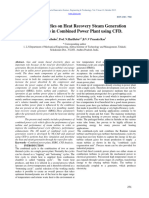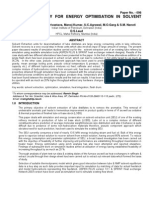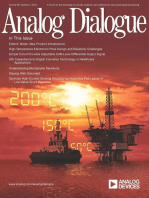Hitachi Boiler PDF
Hitachi Boiler PDF
Uploaded by
Richard Andrianjaka LuckyCopyright:
Available Formats
Hitachi Boiler PDF
Hitachi Boiler PDF
Uploaded by
Richard Andrianjaka LuckyOriginal Title
Copyright
Available Formats
Share this document
Did you find this document useful?
Is this content inappropriate?
Copyright:
Available Formats
Hitachi Boiler PDF
Hitachi Boiler PDF
Uploaded by
Richard Andrianjaka LuckyCopyright:
Available Formats
Completion of Hitachinaka Thermal Power Station Unit No.
1— 1,000-MW Power Generating Plant of The Tokyo Electric Power Co., Inc. — 104
Completion of Hitachinaka Thermal Power Station Unit No. 1
— 1,000-MW Power Generating Plant of The Tokyo Electric Power Co., Inc.—
Nobuyuki Matsumoto OVERVIEW: In recent years, from the viewpoint of environmental
Hideaki Iwamoto conservation, it has become a top priority to improve the heat efficiency of
thermal power plants. Under such circumstances, in December 2003, a
Takao Kaneda 1,000-MW coal-fired power plant with the world’s highest efficiency — Unit
Koichi Shigihara No. 1 of Hitachinaka Thermal Power Station of The Tokyo Electric Power
Co., Inc. — was put into service. This generator consists of a coal-fired
boiler with an extremely high critical pressure and a main steam temperature
of 600°C as well as a state-of-the-art steam turbine with 41-inch-long (about
104 cm) final-stage turbine blades. Hitachi, Ltd. was in charge of the design
and construction of the facilities for these two main components (i.e. the
boiler and turbine) of Unit No. 1. Upon completing the plant design, Hitachi
drew upon its collective strengths and latest technologies to develop these
components. That is, by introducing the large-capacity, coal-fired boiler —
which can handle many varieties of coal and meet the optimum steam
conditions through increased pressure and temperature — and the high-
efficiency steam turbine, both plant efficiency and reliability have been
improved. Furthermore, a newly developed remote-monitoring system
installed in the central control room of the plant utilizes expanded-display
devices [large-size LCD (liquid crystal display) displays] and wider-scope
operation by means of highly functional CRT (cathode ray tube) displays.
As a result of this system set-up, plant operation in terms of labor saving
and monitorability is improved. In addition, the remote-monitoring system
is directly connected to the switchgear for auxiliary electrical equipment;
consequently, the amount of cable materials used is reduced and the
construction cost is lowered.
INTRODUCTION 2003. Regarding the main facilities of this power plant,
CONSTRUCTION of the boiler of Unit No. 1 of Hitachi, Ltd. took charge of the design and construction
Hitachinaka Thermal Power Station of The Tokyo of the boiler and turbine generator of Unit No. 1.
Electric Power Co., Inc. was started in July, 1999, and Taking full advantage of its collective strength in terms
the unit went into commercial operation in December of plant engineering and technical skills, Hitachi
Fig. 1—View of Completed
Hitachinaka Thermal Power Station.
Located at Hitachinaka Thermal
Power Station, Hitachinaka Port
north quay Ibaraki Prefecture, Japan,
Unit No. 1 — a 1,000-MW power-
generation plant — was completed in
December, 2003.
Hitachi Review Vol. 53 (2004), No. 3 105
TABLE 1. Comparison of Design
Item Unit Shinchi Unit No. 1 Hitachinaka Unit No. 1
Specifications of Two Power-
generation Plants Rated power MW 1,000 1,000
Basic MPa 24.1 24.5
By adopting higher steam pressure design Steam conditions (main/reheat)
and temperature conditions, thermal °C 538/566 600/600
conditions
efficiency of Hitachinaka Unit No. 1 Fuel — Coal Coal
is 4.5% higher than Shinchi Type — Ultra-high critical pressure, variable through flow
Unit No. 1. Steam pressure MPa 25.0 25.4
Boiler
Steam temperature °C 542/567 604/602
Main Evaporation volume t/h 3,080 2,870
machine Type — Two-axis four-flow discharge
spec. Turbine Revolution speed min–1 3,000/1,500 3,000/1,500
Discharge vacuum pressure kPa –97.06 (728 mmHg) –96.26 (722 mmHg)
Type Horizontal-cylinder revolving magnetic field
Generator
Capacity MVA 634.8/519.9 675.0/488.0
Thermal efficiency % 41.89 43.78
successfully completed construction of these two key technology further improves efficiency.
facilities of this 1,000-MW power-generation plant and
achieved world-leading thermal efficiency and Boiler Design
reliability. As for the boiler furnace specification, since high-
In the following sections, the main features of the temperature steam at 600/600°C is used, a variable-
two facilities designed and constructed by Hitachi — pressure-operation Benson boiler with a high-
namely, the boiler and turbine generator — and the reliability spiral water wall is adopted. A schematic
technologies applied are described. cross section of Hitachinaka Unit No. 1 is shown in
Fig. 2.
OVERVIEW OF PLANT DESIGN As for the boiler design, streamlining the facility
Table 1 compares the specifications of the new led to improvement in operation characteristics and
Hitachinaka No. 1 Unit and that of an existing unit maintainability.
with the same rated output power (i.e. No. 1 Unit of
Shinchi Thermal Power Station (hereafter referred to
simply as Shinchi Unit No. 1) developed in
collaboration with Soma Kyodo Power Co., Ltd.).
As regards the basic design of Unit No. 1 of
Hitachinaka Thermal Power Station (hereafter referred
to simply as the Hitachinaka Unit No. 1), it is clear
that the Hitachinaka Unit No. 1 seeks higher thermal
efficiency and optimized economic efficiency through
increased steam pressure and temperature conditions.
That is, compared to the design thermal efficiency of
the Shinchi Unit No. 1, that of Hitachinaka Unit No. 1
(under a main steam pressure of 24.5 MPa and main/
reheat steam temperatures of 600°C) is 4.5% higher.
NEW BOILER TECHNOLOGY
As for the high-efficiency operation of the new
boiler facility, by applying high-temperature, high-
elevated temperature strength materials adapted to Fig. 2—Side Structural View of Boiler of Hitachinaka Thermal
high-temperature, high-pressure steam under so-called Power Station Unit No. 1.
maximum-level conditions, high reliability can be The plant design combines the latest high-strength materials in
sustained. And improving combustion performance by the high metal-temperature range to attain high reliability and
means of utilizing the latest pulverized-coal-firing high economical efficiency.
Completion of Hitachinaka Thermal Power Station Unit No. 1— 1,000-MW Power Generating Plant of The Tokyo Electric Power Co., Inc. — 106
The main features of the boiler are listed below: NEW STEAM TURBINE AND SYSTEM
(1) Hitachi’s latest pulverized-coal burner (NR3) TECHNOLOGIES
improves burning efficiency and decreases NO x By applying the latest technologies under high-
emission. temperature conditions for the main steam and reheat
(2) By aligning all boiler reheater horizontally, steam, the steam turbine attains high efficiency and
controllability of steam temperature in the parallel gas high reliability. Furthermore, in the construction phase
damper is improved, so a gas-recirculation system is of the plant facilities, the steam turbine was made more
not required. compact.
(3) Enlarging the heat-absorption in the furnace results
in non-uniform temperature distribution in the water New Steam Turbine Technology
wall; therefore, a mixing bottle is located at the outlet Since the steam turbine operates under high-
of the spiral water wall to mitigate the non-uniform temperature-steam conditions, the main parts must
temperature distribution. handle temperatures of 600°C. Accordingly, the main-
(4) Large-scale modular design using a sling-type tube steam stop valve, regulator valve, and combined reheat
support for the horizontal heating surface is used for valve are made of 9Cr-1Mo steel; the inside casing of
the first time. As a result, using various module designs the high-pressure turbine is made of Cr-Mo-V-B steel;
shortens construction time and, thus, improves and the inside casing of the intermediate-pressure
efficiency. turbine is made of 12Cr steel.
Moreover, on top of the improved combustion
High-efficiency Combustion Technology efficiency brought by the increased steam temperature,
In recent years, to simplify combustion facilities, overall efficiency is improved as a result of the
the capacity of burners has been increased. In the new implementation of the latest AVN (advanced vortex
plant facility, 36 Hitachi-NR3 burner units are installed nozzle). A photograph of the completed steam turbine-
— providing the maximum capacity in Japan. generator is given in Fig. 4.
Regarding the Hitachi NR3 burner, in addition to
the denitration technology used in Hitachi’s standard Characteristics of System Configuration
low-NOx pulverized-coal (NR2), a guide sleeve and In regards to the configuration of the system for
flame stabilizing ring with a baffle plate are applied. the heat cycle (steam extraction, charging, and
As a result of this, a flow pattern of the secondary and condensation), a structure that works well in a 1,000-
tertiary air is optimized; consequently, a high- MW power generator is used. Moreover, from the
temperature reducing flame is enlarged and the NOx viewpoint of compactness, various features of the
emission is reduced. auxiliary equipment have been elaborately designed.
The main features of the system configuration are listed
as follows:
(1) Steam extraction, charging, and condensation
Guide sleeve
Powdered coal plus
primary air
3D flow
2D flow
Powdered-coal
concentrator
2D: two-dimensional
Baffle plate 3D: three-dimensional
Fig. 3—Structure of Hitachi-NR3 Burner.
By utilizing Hitachi’s low-NOx NR3 burner, even lower NOx Fig. 4—View of Steam Turbine-generator Facility.
emission, along with better combustibility and flame stability, is Completed steam turbine-generator applying the latest
attained. technology is shown.
Hitachi Review Vol. 53 (2004), No. 3 107
The feedwater heater consists of a low-pressure, points for collecting data (2,200 analog and 20,000
four-step deaerator and a high-pressure, four-step digital). This large-scale system coverage is provided
deaerator. The condensate pump and its booster pump by the Hitachi Integrated Automatic Control System
are comprised of two units, each with 50% capacity; (HIACS).
while the feedwater pump is comprised of two 50%- The HIACS is composed of distributed computer
capacity turbine-driver units and one low pump-head (RS-90/400) with automization and control functions,
motor-driver unit feedwater pump for plant start-up FA (factory automation) PCs with operation
and shutdown. monitoring functions, and a high-speed, large-capacity
(2) Simplified deaerator controller series with control and safety functions. All
Compared to a conventional deaerating chamber these devices are connected via high-speed network
for removing dissolved oxygen from the boiler — called µ∑-100 — to form an “all digital” system.
feedwater — which has a flush tank for the boiler water The characteristic features of this large-scale
made from two blow molds — the new steam-turbine remote-control system, HIACS, are outlined in the
system has a enlarged flush tank made from a single following sections.
mold. Accordingly, this monohull-type flush tank with
a built-in deaeration capability is more compact and Human-machine Interface
takes up less space. (1) As well as integrating and sharing information, the
(3) Cleaning filter HMI (human-machine interface) achieves excellent
Up till now, the steam condenser has utilized a six- operability and controllability by utilizing a four-
valve-switching backwash method. The new screen multi-window system provided by 110-type
condenser, however, features a large-size cleaning filter expanded-display devices [large-size LCDs (liquid
at the input of the water chamber of the condenser. As crystal displays)].
well as improving the operation of the steam-condenser A view of the main operator’s control panel of the
cooling system, introduction of this filter makes setting central control room is shown in Fig. 5.
up the circulating water system more efficient. (2) CRT operation is achieved by the distributed FA
PCs and expanded-display devices by PC mouse
REMOTE PLANT-MONITORING CONTROL operation. As well as covering the conventional range
SYSTEM of control devices, it also extends to auxiliary electrical
The facilities of the above-described 1,000-MW devices, so the main operator’s control panel of the
large-capacity coal-fired power plant are monitored
by a large-scale remote-control system consisting of
700 auxiliary units for coarse control and monitoring
Direct-remote-
Metal-cable system
communication system
HIACS HIACS
Controller Controller
(automization logic) (automization logic)
Control Control
device PCM device PCM
(auxiliary protection (auxiliary protection
logic) logic)
Metal cable Direct-remote-
communication
Input/output interface device system
Communication
Metal cable cable
Switchgear Switchgear
Plant auxiliaries Plant auxiliaries
Fig. 5—View of Main Operator Control Panel and Expanded- PCM: programmable control module
Display Devices in Central Control Room.
An HMI centered on 110-type expanded-display devices is Fig. 6—Interface between Control Devices and Switchgears.
adopted, and the integration of data enables the central control By utilizing remote-communication methods, the control system
room to be streamlined. can be significantly streamlined.
Completion of Hitachinaka Thermal Power Station Unit No. 1— 1,000-MW Power Generating Plant of The Tokyo Electric Power Co., Inc. — 108
central control room can be made more compact. CONCLUSIONS
This paper described the main features of the boiler
Interface between Control Devices and and turbine-generator of Unit No. 1 of Hitachinaka
Switchgears Thermal Power Station of The Tokyo Electric Power
The conventional interface between control devices Co., Inc., and outlined the latest technologies applied
and switchgears utilizes metal cables; however, the new in these facilities. Applying these new technologies
plant-control system uses remote communication enables stable operation of these coal-burning-power-
between these devices as shown schematically in Fig. plant facilities at high efficiency and large capacity.
6. In the future, Hitachi Group intends to apply these
Each switchgear is fitted with a communication technical achievements in other thermal power plants.
function so that it can communicate directly with a In particular, focusing on development of technologies
corresponding control device. As a result, the operating for even higher efficiency and more plant streamlining,
control panel is made more compact and the cable- we are striving toward construction of sustainable
engineering work is made significantly more efficient. thermal power plants.
Improving Reliability of Boiler and Turbine- ACKNOWLEDGMENTS
generator Safety Systems The authors would like to express their sincere
Regarding the boiler and turbine safety panel, to thanks to all those concerned at The Tokyo Electric
assure higher reliability than that attainable up till now, Power Co., Inc., for their considerable assistance —
a triple system consisting of a PCM — equipped with from planning, to construction and testing, and up to
a ROM (read-only memory) and CPU (central final commissioning — in developing the Unit No. 1
processing unit) — is connected to a protection circuit. of Hitachinaka Thermal Power Station.
And a dual system is set up to cover abnormal-state
detection and alarm monitoring by the detection REFERENCES
elements and calculation circuitry. In conjunction with (1) R. Okura et al., “Completion of a High-efficiency Coal-fired
a digital protective relay board for protecting the Power Plant; Hitachi Hyoron, 85, pp. 163-166 (Feb. 2003) in
generator machinery and main transformer, the above- Japanese.
described configuration has enabled the protection (2) K. Umezawa et al., “Kin No. 1 1220 MW Thermal Power
Station,” Hitachi Hyoron, 85, pp. 167-170 (Feb. 2003) in
circuit to be completely digitized.
Japanese.
ABOUT THE AUTHORS
Nobuyuki Matsumoto Takao Kaneda
Joined Hitachi, Ltd. in 1979, and now works at the Joined Hitachi, Ltd. in 1971, and now works at the
Electrical and I&C System Engineering Section, the Power Generation Control Systems Planning
Thermal Power Plant Engineering Department, Department, the Information Control Systems
Hitachi Works, the Power Systems. He is currently Division of the Information & Telecommunication
engaged in basic planning of instrumentation and Systems. He is currently engaged in drawing up plans
control of thermal power plants. Mr. Matsumoto can for thermal-power control systems. Mr. Kaneda can
be reached by e-mail at be reached by e-mail at
nobuyuki_matsumoto@pis.hitachi.co.jp. takao_kaneda@pis.hitachi.co.jp.
Hideaki Iwamoto Koichi Shigihara
Joined Babcock-Hitachi K.K. in 1994, and now works Joined Hitachi Engineering Co., Ltd. in 1992, and
at the Boiler Design Section of the Thermal now works at the No. 1 Engineering Division of the
Engineering Department of Kure Office. He is Electrical Power Systems Headquarters. He is
currently engaged in basic planning and development currently engaged in engineering work on thermal
of commercial boilers. Mr. Iwamoto can be reached power systems. Mr. Shigihara can be reached by
by e-mail at iwamoto-h@kure.bhk.co.jp. e-mail at kouichi_shigihara@pis.hitachi.co. jp.
You might also like
- As NZS 2293.2-1995 Emergency Evacuation Lighting For BuildinDocument16 pagesAs NZS 2293.2-1995 Emergency Evacuation Lighting For BuildinHà Quang TrungNo ratings yet
- Assignment Report: Simple Operating SystemDocument24 pagesAssignment Report: Simple Operating SystemNguyen Trong Tin50% (2)
- GiftcardMethod July 2022Document9 pagesGiftcardMethod July 2022Kannada Rapper100% (1)
- Bhikki Power Plant ReportDocument33 pagesBhikki Power Plant ReportShahbazZahid80% (5)
- Wiring HarnessDocument23 pagesWiring HarnessRichard Andrianjaka LuckyNo ratings yet
- Experiences in Designing and Operating The Latest 1,050-MW Coal-Fired BoilerDocument5 pagesExperiences in Designing and Operating The Latest 1,050-MW Coal-Fired BoilerswatkoolNo ratings yet
- 700 MW Plant DescripionDocument6 pages700 MW Plant Descripionsathesh100% (1)
- Commercial Operation of 600 MW UnitDocument5 pagesCommercial Operation of 600 MW Unitwaleed emaraNo ratings yet
- Application of Leading-Edge High-Efficiency USC Lignite-Fired Power Plant in Turow, PolandDocument4 pagesApplication of Leading-Edge High-Efficiency USC Lignite-Fired Power Plant in Turow, PolandDenkaNo ratings yet
- State-Of-The-Art Technologies For The 1,000-Mw 24.5-Mpa/ 600°C/600°C Coal-Fired BoilerDocument4 pagesState-Of-The-Art Technologies For The 1,000-Mw 24.5-Mpa/ 600°C/600°C Coal-Fired BoilerRezwana SarwarNo ratings yet
- Research and Practice of 600MW Subcritical Steam TDocument9 pagesResearch and Practice of 600MW Subcritical Steam TNguyenloc2909No ratings yet
- Development of Large Capacity Turbine Generators For Thermal Power PlantsDocument8 pagesDevelopment of Large Capacity Turbine Generators For Thermal Power PlantsSureshYarlagaddaNo ratings yet
- r2002 Technology PsDocument9 pagesr2002 Technology PsmettisamiNo ratings yet
- Development of Large-Capacity Indirect Hydrogen-Cooled Turbine Generator and Latest Technologies Applied To After Sales ServiceDocument7 pagesDevelopment of Large-Capacity Indirect Hydrogen-Cooled Turbine Generator and Latest Technologies Applied To After Sales Service권용수No ratings yet
- Thermal Power PlantDocument16 pagesThermal Power Plantmprasad_veena100% (1)
- A Case Study On Thermodynamic Analysis of Cogeneration Power Plant (IRJET-V2I9163)Document5 pagesA Case Study On Thermodynamic Analysis of Cogeneration Power Plant (IRJET-V2I9163)luis hyungNo ratings yet
- Ird Cet Paper UscDocument3 pagesIrd Cet Paper UscMohamed Abashar MusmarNo ratings yet
- Operation Results of IHI Flue Gas Desulfurization System - Unit No.1 (1000 MW) of Hitachinaka Thermal Power Station For TEPCODocument5 pagesOperation Results of IHI Flue Gas Desulfurization System - Unit No.1 (1000 MW) of Hitachinaka Thermal Power Station For TEPCODaniel DubeNo ratings yet
- Various Applications of High-Efficiency H-25 Gas TurbineDocument6 pagesVarious Applications of High-Efficiency H-25 Gas Turbinehar keramasanNo ratings yet
- PGU 9 HitchiNclrTrbnsDocument10 pagesPGU 9 HitchiNclrTrbnsMario F Navarro100% (1)
- performance test procedure 最终提交业主版 - 都利项目性能试验大纲(英文)2014-9-30 PDFDocument36 pagesperformance test procedure 最终提交业主版 - 都利项目性能试验大纲(英文)2014-9-30 PDFarunrajmech09100% (1)
- Future Development of Electric Equipment Manufacturing: High Efficiency, Energy Saving, Environmental ProtectionDocument31 pagesFuture Development of Electric Equipment Manufacturing: High Efficiency, Energy Saving, Environmental ProtectionblazegloryNo ratings yet
- Supercritical Benson BoilerDocument18 pagesSupercritical Benson BoilerJerry Mateo100% (2)
- Super Critical Boiler Technology MaturesDocument24 pagesSuper Critical Boiler Technology MaturespapudasNo ratings yet
- FER-56-4-123-2010 Recent Technologies For Steam TurbinesDocument7 pagesFER-56-4-123-2010 Recent Technologies For Steam TurbinesNgoc Thach PhamNo ratings yet
- Alali 2018Document8 pagesAlali 2018ankitNo ratings yet
- Annex 6.1.6-2 Description and Drawings of Steam Turbine (Eng) PDFDocument21 pagesAnnex 6.1.6-2 Description and Drawings of Steam Turbine (Eng) PDFvschintapalliNo ratings yet
- BFPDocument10 pagesBFPRezky AwanNo ratings yet
- Development of Tandem-Compound 1,000-MW SteamDocument7 pagesDevelopment of Tandem-Compound 1,000-MW Steamraj38No ratings yet
- KSTPSDocument23 pagesKSTPSakshatjain70233No ratings yet
- Usp010318 GTCC081Document10 pagesUsp010318 GTCC081Christian WilhelmNo ratings yet
- Thermodynamic Analysis of Triple Pressure Heat Recovery Steam GeneratorDocument7 pagesThermodynamic Analysis of Triple Pressure Heat Recovery Steam GeneratorrudisamosirNo ratings yet
- Overview of Mejia Thermal Power StationDocument35 pagesOverview of Mejia Thermal Power StationNitish KhalkhoNo ratings yet
- Steam Turbine Thermal Stress Online Monitoring Technology - EPRI PDFDocument84 pagesSteam Turbine Thermal Stress Online Monitoring Technology - EPRI PDFChetan Atrai100% (3)
- Zagarola 2004Document12 pagesZagarola 2004sxasxasxNo ratings yet
- A Case Study On Heat Rate of Boiler and Turbine in NSPCL DurgapurDocument10 pagesA Case Study On Heat Rate of Boiler and Turbine in NSPCL DurgapurRajneesh KaushalNo ratings yet
- Journal - Assignment 1Document9 pagesJournal - Assignment 1wanilham2002No ratings yet
- Chapter CogenerationDocument6 pagesChapter Cogenerationpratosh1313No ratings yet
- Power Plant Engineering Digital MaterialDocument184 pagesPower Plant Engineering Digital MaterialSricharan MedaNo ratings yet
- Assignment 1 SolutionDocument7 pagesAssignment 1 SolutionShreyas TawareNo ratings yet
- Ijiset V2 I10 37Document12 pagesIjiset V2 I10 37Ram HingeNo ratings yet
- Benson Babcock HitachiDocument6 pagesBenson Babcock HitachiHandrea Hadi SaputraNo ratings yet
- ABWRDocument14 pagesABWRBubai111No ratings yet
- Constraint Analysis of A MicroturbineDocument88 pagesConstraint Analysis of A Microturbinegarga100% (4)
- Simulation Study of Lube Based Extraction UnitDocument5 pagesSimulation Study of Lube Based Extraction Unitrvsingh100% (2)
- 07 Power CyclesDocument122 pages07 Power CyclesNahfi JimNo ratings yet
- 12 - Chapter 6 PDFDocument13 pages12 - Chapter 6 PDFGanesh DasaraNo ratings yet
- Resent Development PDFDocument4 pagesResent Development PDFAnurag porteNo ratings yet
- NTPC Plant Dadri (2003) PlainDocument28 pagesNTPC Plant Dadri (2003) PlainpalanilNo ratings yet
- Supercritical Steam Generator: A Seminar Report OnDocument9 pagesSupercritical Steam Generator: A Seminar Report OnPranjal SrivastavaNo ratings yet
- Recent Technology in Steam TurbineDocument6 pagesRecent Technology in Steam TurbineIsmail RahimNo ratings yet
- Carrier XP ENERGY Air To Water Heat PumpDocument2 pagesCarrier XP ENERGY Air To Water Heat PumpZeljko DjukicNo ratings yet
- Energy: Yang Wang, Zhijun Zhou, Junhu Zhou, Jianzhong Liu, Zhihua Wang, Kefa CenDocument5 pagesEnergy: Yang Wang, Zhijun Zhou, Junhu Zhou, Jianzhong Liu, Zhihua Wang, Kefa CenKean PascualNo ratings yet
- Thermodynamic Performance of Molten Salt Heat StorDocument6 pagesThermodynamic Performance of Molten Salt Heat Stormxc2425No ratings yet
- Construction and Operation of Gas-Steam Combined Cycle Plant For Higashi Niigata Thermal Power Station No. 3Document8 pagesConstruction and Operation of Gas-Steam Combined Cycle Plant For Higashi Niigata Thermal Power Station No. 3Win Min OoNo ratings yet
- Boiler StudyDocument158 pagesBoiler Studykarthikraja21100% (3)
- USC Steam Turbine TechnologyDocument17 pagesUSC Steam Turbine TechnologyteijarajNo ratings yet
- Chap 27 PDFDocument22 pagesChap 27 PDFnelson escuderoNo ratings yet
- Trends and Future Outlook For Thermal Power Plants: Hiroshi NishigakiDocument5 pagesTrends and Future Outlook For Thermal Power Plants: Hiroshi NishigakiYogesh BhattNo ratings yet
- Biomass GensetDocument7 pagesBiomass GensetPauloCPinheiroNo ratings yet
- Handbook of Electrical Engineering: For Practitioners in the Oil, Gas and Petrochemical IndustryFrom EverandHandbook of Electrical Engineering: For Practitioners in the Oil, Gas and Petrochemical IndustryNo ratings yet
- A Polygeneration Process Concept for Hybrid Solar and Biomass Power Plant: Simulation, Modelling, and OptimizationFrom EverandA Polygeneration Process Concept for Hybrid Solar and Biomass Power Plant: Simulation, Modelling, and OptimizationNo ratings yet
- Engine Cooling - ID4 2.2L Diesel - : Item SpecificationDocument30 pagesEngine Cooling - ID4 2.2L Diesel - : Item SpecificationRichard Andrianjaka LuckyNo ratings yet
- JLR Diagnosis and Testing 1Document14 pagesJLR Diagnosis and Testing 1Richard Andrianjaka LuckyNo ratings yet
- JLR Diagnosis and Testing 3Document6 pagesJLR Diagnosis and Testing 3Richard Andrianjaka LuckyNo ratings yet
- Battery and Charging System - General Information - Battery CareDocument20 pagesBattery and Charging System - General Information - Battery CareRichard Andrianjaka LuckyNo ratings yet
- Module Communication NetworkDocument1 pageModule Communication NetworkRichard Andrianjaka LuckyNo ratings yet
- Fuel System - General Information - Diesel Filter Water Drain-OffDocument7 pagesFuel System - General Information - Diesel Filter Water Drain-OffRichard Andrianjaka LuckyNo ratings yet
- JLR Diagnosis and Testing 2Document8 pagesJLR Diagnosis and Testing 2Richard Andrianjaka LuckyNo ratings yet
- Glow Plug System - ID4 2.2L Diesel - : Item NM LB-FTDocument7 pagesGlow Plug System - ID4 2.2L Diesel - : Item NM LB-FTRichard Andrianjaka LuckyNo ratings yet
- Engine - ID4 2.2L Diesel - : Item SpecificationDocument104 pagesEngine - ID4 2.2L Diesel - : Item SpecificationRichard Andrianjaka Lucky100% (1)
- Ben-Ya Industrial Co., LTD.: Seq. Photo Oem - No DescriptionDocument8 pagesBen-Ya Industrial Co., LTD.: Seq. Photo Oem - No DescriptionRichard Andrianjaka LuckyNo ratings yet
- Module Configuration: Special Tool(s)Document10 pagesModule Configuration: Special Tool(s)Richard Andrianjaka Lucky100% (1)
- Canon Imagerunner 2018 Fuser (Fixing) Unit - 120 Volt (Genuine)Document1 pageCanon Imagerunner 2018 Fuser (Fixing) Unit - 120 Volt (Genuine)Richard Andrianjaka LuckyNo ratings yet
- Control Unit I/O: Jam Buzzer Universal Controller Board PWMDocument1 pageControl Unit I/O: Jam Buzzer Universal Controller Board PWMRichard Andrianjaka Lucky100% (1)
- D D D D D D D: MC3487 Quadruple Differential Line DriverDocument7 pagesD D D D D D D: MC3487 Quadruple Differential Line DriverRichard Andrianjaka LuckyNo ratings yet
- Andrianjaka Andrianjaka: Bfs Id Bfs IdDocument1 pageAndrianjaka Andrianjaka: Bfs Id Bfs IdRichard Andrianjaka LuckyNo ratings yet
- Software Installation WindowsDocument1 pageSoftware Installation WindowsRichard Andrianjaka LuckyNo ratings yet
- Mozilla ProfixDocument18 pagesMozilla ProfixRichard Andrianjaka LuckyNo ratings yet
- Steam Generation in Organic Food Processing SystemsDocument12 pagesSteam Generation in Organic Food Processing SystemsRichard Andrianjaka LuckyNo ratings yet
- Boiler 4Document4 pagesBoiler 4Richard Andrianjaka LuckyNo ratings yet
- HPC Technical Services: BoilerDocument18 pagesHPC Technical Services: BoilerRichard Andrianjaka LuckyNo ratings yet
- Tekla Structural Designer 2022 British Standards ReferenceDocument72 pagesTekla Structural Designer 2022 British Standards Referencedanielamaican8No ratings yet
- Annotated-PORA Tech ACADEMY NDADocument10 pagesAnnotated-PORA Tech ACADEMY NDA5zgrj6cyt4No ratings yet
- GST Interplay On It-ITes EcosystemDocument73 pagesGST Interplay On It-ITes EcosystemHarsh guptaNo ratings yet
- PDF File From ALV - SAP Q&ADocument3 pagesPDF File From ALV - SAP Q&Aphogat projectNo ratings yet
- KaplanDocument17 pagesKaplanatif naeemNo ratings yet
- E TechDocument36 pagesE TechShania Mich Wapelle SuasulaNo ratings yet
- Chapter 8-Statistical Inference - Updated 27 December 2022 GCDocument18 pagesChapter 8-Statistical Inference - Updated 27 December 2022 GCalmi debeleNo ratings yet
- Responsibility Assignment MatrixDocument5 pagesResponsibility Assignment MatrixMuhammadMuzammalJamilNo ratings yet
- Review Questions: B) Problem SolverDocument7 pagesReview Questions: B) Problem SolverShariar Parvez TonmoyNo ratings yet
- Encryption & Hytera Terminals: Encryption Type Algorithm DescriptionDocument1 pageEncryption & Hytera Terminals: Encryption Type Algorithm DescriptionDavyAvicenneNo ratings yet
- Understanding Data Deletion and Data Recovery in WindowsDocument29 pagesUnderstanding Data Deletion and Data Recovery in WindowsIzazi MubarokNo ratings yet
- TL Saaty Decision Making For Leaders HackathonDocument6 pagesTL Saaty Decision Making For Leaders HackathonthiagoportoengNo ratings yet
- How To Design and 3D Print Flexible MeshesDocument13 pagesHow To Design and 3D Print Flexible MeshesdahauanchengNo ratings yet
- Module Code & Module Title: CS6PO5Final Year ProjectDocument13 pagesModule Code & Module Title: CS6PO5Final Year ProjectAayush ShahiNo ratings yet
- Describing Books KET Listening WorksheetDocument1 pageDescribing Books KET Listening WorksheetkristiyanakrasenovaasenovaNo ratings yet
- Manual - VisVAP 216 ENGDocument55 pagesManual - VisVAP 216 ENGVianAndrianiNo ratings yet
- Cryptographic Hash FunctionsDocument10 pagesCryptographic Hash FunctionsBiniyam DerjewNo ratings yet
- Ev12aq600 PDSDocument57 pagesEv12aq600 PDSЕвгений ИвановNo ratings yet
- SmartPad FlyerDocument2 pagesSmartPad FlyerMiguel SalcedoNo ratings yet
- FCHN-Module 6 - Overview of ISO - OSI Model and Networking Devices - 2022Document33 pagesFCHN-Module 6 - Overview of ISO - OSI Model and Networking Devices - 2022mirchigamers7100% (1)
- Accuracy Calibration For SK-600IDocument5 pagesAccuracy Calibration For SK-600IDEPARTAMENTO BIOMEDICO100% (1)
- Stock Transport Order (STO) Process in SAPDocument27 pagesStock Transport Order (STO) Process in SAPPrateek Mohapatra100% (2)
- FYP Proposal 2.TTGS by UOL TempleteDocument9 pagesFYP Proposal 2.TTGS by UOL Templete70078924No ratings yet
- Cache Data Size: 32 Kib Cache Block Size: 2 Words Cache Access Time: 1 CycleDocument2 pagesCache Data Size: 32 Kib Cache Block Size: 2 Words Cache Access Time: 1 CycleĐức TàiNo ratings yet
- Physical Inventory ConfigurationDocument43 pagesPhysical Inventory ConfigurationJAYADEVAN TJNo ratings yet
- FuntionsDocument22 pagesFuntionsFaheem AwaisNo ratings yet
- Tasmay Ip ProjectDocument13 pagesTasmay Ip ProjectAshutosh PrajapatiNo ratings yet














































































































